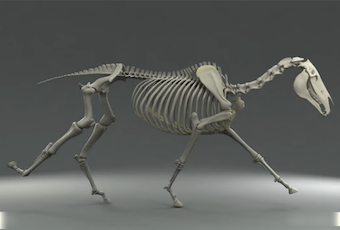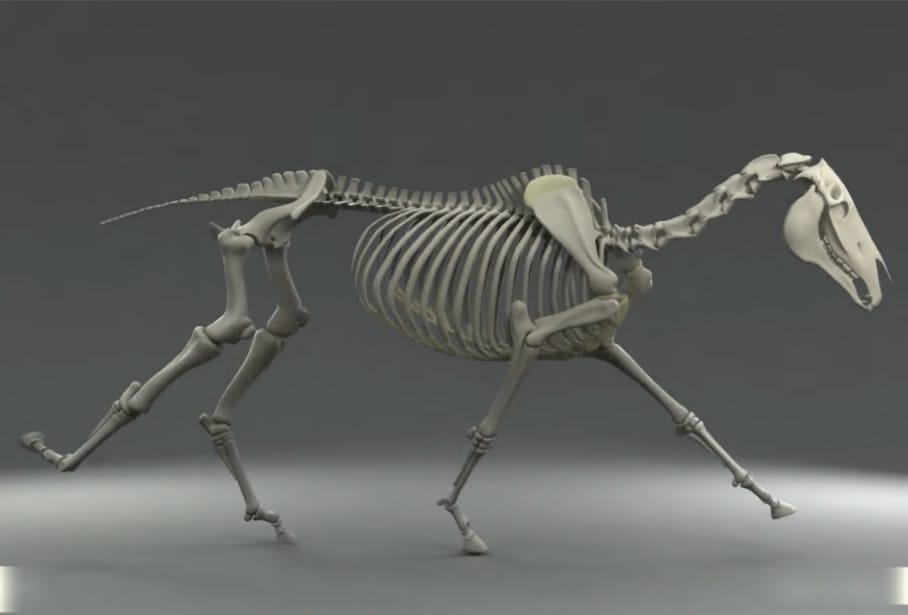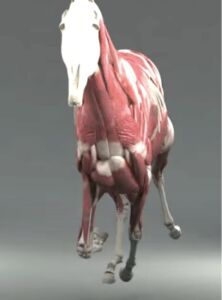
Seeing what’s missing

The true mystery of the world is the visible,
not the invisible.
— Oscar Wilde
Have you ever watched an animation of a horse in motion?
At the beginning of this video, you see an equine skeleton’s limbs moving sequentially. Sections of the spine — between the head and neck at the top and in the tail at the other end — ripple in a wavelike fashion. As you watch, muscle and soft tissue layers appear, followed by the skin, and eventually, the tail and mane materialize.
In his comments, New Zealand digital artist Julian Butler tells us he used photos along with data acquired from motion capture, CT scans, and X-rays to create this simulation. The resulting model serves an admirable purpose: movies can utilize it when it would be too risky to use a live horse or when the script calls for something that a real animal cannot do.
As useful as the model might be, I couldn’t help but notice that something was missing regarding horse movement. Specifically, the chest didn’t change shape, and the rest of the spine wasn’t undulating as the horse moved.
While visualization may fit with the commonly held idea that a ribcage is solid and unmoving, maintaining this stiffness would require an incredible and incessant amount of muscular effort, inhibiting the horse’s natural, necessary trunk motion. The resulting rigidity would interfere with the horse’s ability to breathe, destroy the fluidity of its gait, eliminate shock absorption and force transmission, and make locomotion clunky and dangerously inefficient.
The Feldenkraisian insight that the chest is more of a rib basket than a cage is central to understanding well-organized whole-body movement. Though the distributed movements of the chest – breast bone, ribs, and the vertebrae they attach to – may be small, they are essential to economic, coordinated action, whether considering horses or humans in motion.
If you’re interested in learning about the gait patterns of horses, I recommend the informative Horses and Us website. Their YouTube videos analyzing each form of locomotion, like this one about the gallop, are genuinely enlightening. This slow-motion video of a galloping horse is also excellent.
(In case you don’t know, you can slow YouTube videos down — or speed them up — by clicking on the image, finding the gear icon, and then selecting playback speed. Watching animals and people move in slow motion is incredibly helpful in developing observational acuity and becoming a better movement detective.)
 Is the horse’s motion in the video the classic four-beat rhythm of a gallop, or is it a canter? It’s difficult to tell without hearing the footfalls.
Is the horse’s motion in the video the classic four-beat rhythm of a gallop, or is it a canter? It’s difficult to tell without hearing the footfalls.
When I stopped the video, it looked like all four limbs were in the air, which would make it a gallop.
What do you think?
The significance of the movement of the chest and spine in human locomotion is central to Unlocking the Spinal Engine, the post-graduate program I presented in Florence, Munich, and Paris in 2023.
If you are ready to learn more about improving your student’s ability to walk, you might like to know I will be offering this course again this year. I’m teaching it in Boulder, Colorado, from April 4th to 7th and Vienna, Austria, from June 6th to 9th. (You can watch this short video to learn more about this fascinating advanced Feldenkrais program.)
Early enrollment in the Boulder programs ends tomorrow, Tuesday, the 5th of March, 2024, so you will have to sign up soon to save on tuition.
Your thoughts?
Please let us know your perspective! Add your comments, reactions, suggestions, ideas, etc., by first logging in to your Mind in Motion account and then clicking here.
Commenting is only available to the Mind in Motion Online community.
Join in by getting your free account, which gives you access to the e-book edition of Articulating Changes (Larry's now-classic Master's thesis), ATM® lessons, and more — all at no charge whatsoever.
To find out more and sign up, please click here.
Please share this blog post
 This work is licensed under a Creative Commons Attribution-ShareAlike 4.0 International License
This work is licensed under a Creative Commons Attribution-ShareAlike 4.0 International License
This blog may contain one or more affiliate links. When you click on a link and then make a purchase, Mind in Motion receives a payment. Please note that we only link to products we believe in and services that we support. You can learn more about how affiliate links work and why we use them here


Wow, Larry. This is very very cool! Thanks so much for sharing this video of horse’s movements. I own and work with horses, and this is a great instruction tool. Thanks!!!
So glad you appreciated the video, Jane. I’m glad you found it useful as an instructional aid!
You’re welcome, Jane.
I’m so glad you found the video useful as an instructional aid.